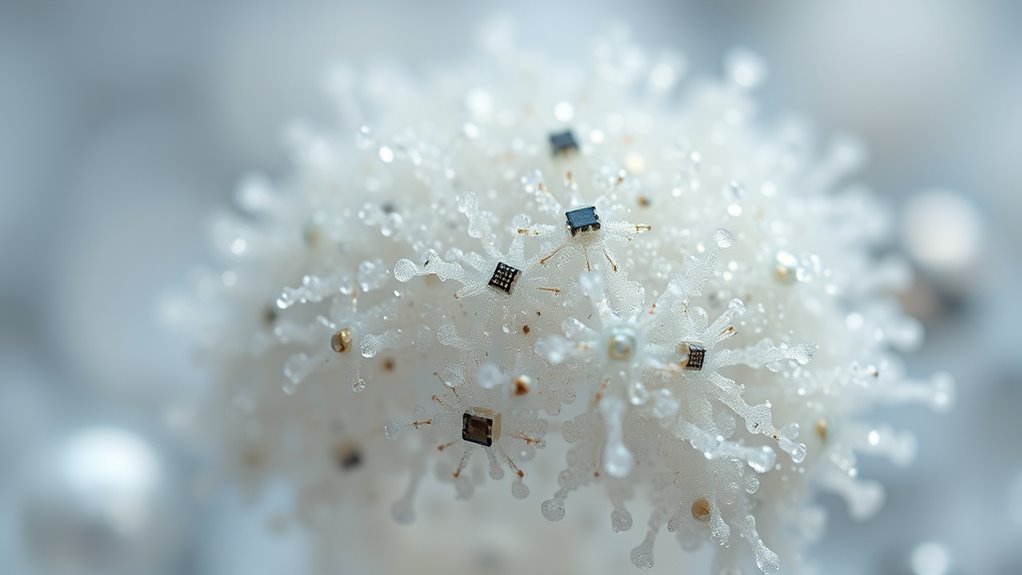Smart dust consists of tiny, wireless sensors that can be dispersed across environments to collect data at a microscopic scale. Using advanced microelectromechanical systems, these sensors monitor everything from health and industrial processes to urban infrastructure and agriculture. They can operate passively by harvesting ambient energy or actively with onboard power. As technology advances, smart dust will become more widespread, transforming how we manage and understand our world—if you want to see how this all works, keep exploring further.
Key Takeaways
- Smart dust consists of tiny, wireless sensors that can monitor environmental conditions, health metrics, and infrastructure in real-time.
- They utilize MEMS technology, nanotechnology, and energy harvesting to operate autonomously and efficiently.
- Deployed across industries like healthcare, agriculture, urban infrastructure, and defense for data collection and analysis.
- Challenges include powering sensors via ambient energy, miniaturization, and ensuring privacy and security.
- Future trends focus on widespread deployment, AI integration, and responsible management to enhance societal safety and efficiency.
Understanding the Core Technology of Smart Dust

Have you ever wondered how tiny sensors can monitor the environment so effectively? It all comes down to microelectromechanical systems, or MEMS, which enable sensors to be incredibly small yet multifunctional. These MEMS sensors incorporate components like microcontrollers, wireless communication modules, and energy harvesters—using solar or vibrational energy—to stay autonomous. High refresh rates allow these sensors to provide real-time data with minimal delay, enhancing their responsiveness and accuracy. Through miniaturization, scientists leverage nanotechnology to create sensors no larger than a grain of sand that can detect environmental parameters such as temperature, humidity, and vibrations. These sensors operate within sensor networks, wirelessly transmitting data in real time for accurate environmental monitoring. The combination of energy harvesting and wireless communication allows these systems to function seamlessly without external power sources. Additionally, advancements in AI integration are enabling smarter sensor networks capable of predictive analytics and adaptive responses, further revolutionizing environmental sensing. The development of wireless communication technologies ensures that these sensors can be deployed in vast and inaccessible areas, expanding their potential applications. Moreover, ongoing research into energy harvesting techniques is enhancing the longevity and reliability of these sensors in the field. Exploring sensor network architectures is also crucial for optimizing data flow and system resilience, making smart dust a revolutionary tool in environmental sensing.
Diverse Types of Smart Dust Systems and Their Functions

Smart dust systems come in various configurations, each designed to suit different monitoring needs and environments. These include passive, active, and hybrid smart dust, all utilizing advanced microelectromechanical systems and sensor technology. Passive smart dust harvests ambient energy like light or vibrations for long-term, low-interference environmental monitoring, relying on energy harvesting techniques, which enable sustainable operation with minimal external input. This approach allows for self-sufficient systems that can operate in remote or inaccessible locations without regular maintenance.
Smart dust systems are adaptable, featuring passive, active, and hybrid configurations for diverse monitoring applications.
Active smart dust contains micro-batteries or micro-generators, enabling autonomous operation and wireless communication without external energy sources. This independence significantly expands their potential applications across diverse fields such as environmental sensing and military surveillance.
Hybrid smart dust combines both features, switching modes based on environmental energy availability for versatile deployment. These systems feature diverse sensor types, tailored to specific tasks, and are optimized for autonomous operation. Their design allows for efficient, real-time data collection across varied environments, advancing the capabilities of microscopic sensor networks. Additionally, the choice of name types can influence the perception and effectiveness of deployed sensors, much like selecting the right dog names enhances a pet’s personality and charm.
Current and Emerging Applications Across Industries

Across various industries, the deployment of smart dust sensors is transforming how data is collected and analyzed. These miniature sensors, part of microelectromechanical systems, enable wireless monitoring across diverse settings. Organic and Natural Juices and other health-focused innovations often utilize advanced sensors to track quality and freshness, highlighting the versatility of these tiny devices.
In industrial environments like refineries and chemical plants, smart dust gathers real-time data for predictive maintenance and safety. Agriculture benefits from soil-embedded sensors that optimize crop health, irrigation, and pest control through precise environmental data collection. Unique and wicked planters demonstrate how innovative designs can enhance indoor gardening, inspiring the development of environmentally friendly sensor housings.
In healthcare, implantable and ingestible sensors monitor vital signs and organ functions from inside the body. Urban areas utilize smart dust for traffic management, air quality, and structural health, improving city safety.
In defense, smart dust supports covert surveillance and hazard detection. These applications highlight smart dust’s expanding role within IoT ecosystems, offering innovative solutions across multiple sectors.
Overcoming Challenges in Deployment and Powering

Powering smart dust sensors presents a significant hurdle due to their tiny size, which limits battery capacity. To address this, you leverage energy harvesting from ambient sources like light, heat, vibrations, or Wi-Fi signals, reducing reliance on traditional batteries. Additionally, developing compact energy harvesting devices tailored for these miniature sensors enhances their autonomy and effectiveness. Furthermore, ongoing research into ambient energy sources helps optimize energy collection methods for various environments, making sensors more versatile. Incorporating innovative miniaturization techniques can further optimize sensor design, making them more efficient and easier to deploy. Overcoming miniaturization challenges involves developing low-power electronics and energy-efficient communication protocols that extend sensor lifespan. Deployment methods must also adapt, emphasizing scalable manufacturing and environmental durability to ensure reliable operation in diverse settings. Wireless power technologies, such as ultrasound, can wirelessly transmit energy deep inside the body or in hard-to-reach areas. These strategies collectively help surmount battery limitations and streamline deployment, enabling embedded sensors to operate efficiently across various applications. Implementing efficient energy management strategies is essential for maximizing the lifespan and performance of these tiny sensors in real-world scenarios. Additionally, integrating Quality Assurance practices ensures consistent sensor performance and reliability during deployment.
Future Trends and Societal Impacts of Microscopic Sensors

As microscopic sensors become more affordable and easier to deploy, their influence on society is poised to grow dramatically. Smart dust sensors will revolutionize environmental monitoring, healthcare, and industrial automation by providing real-time data at an unprecedented scale.
Future trends point toward widespread deployment, enabling IoT devices to operate autonomously and support decision-making in agriculture, urban planning, and disaster response. IoT devices will increasingly rely on these sensors to gather accurate data, reducing human error and enhancing efficiency. However, societal impacts raise concerns about privacy and security, especially as these sensors can covertly gather personal and environmental information.
As adoption accelerates, new norms around data ownership and surveillance will emerge, requiring regulations that balance innovation with privacy rights. The integration of AI will shape autonomous decision-making, transforming how we manage resources and respond to emergencies.
Additionally, the deployment of urban infrastructure sensors in cities like San Francisco and Denver will enhance public services but also necessitate careful governance to prevent misuse. The increasing density of these sensors highlights the importance of establishing privacy safeguards to protect individuals’ rights and prevent unauthorized data collection. Furthermore, understanding privacy policies related to sensor data is crucial for developing responsible deployment strategies that respect individual rights. The development of sensor technologies with built-in security features can help mitigate potential risks associated with widespread data collection.
Frequently Asked Questions
What Are the Disadvantages of Smart Dust?
You should consider the disadvantages of smart dust, like its high development and manufacturing costs that make it less practical for disposable uses. Power management is tricky because tiny batteries are hard to miniaturize, and energy harvesting mightn’t be enough.
Deployment is difficult due to environmental factors, and security risks like data breaches increase as networks grow. Ethical concerns about privacy invasion also raise serious questions about its widespread use.
What Does Smart Dust Do to Your Body?
You might wonder what smart dust does to your body. It monitors your essential signs, tracks your health, and detects early signs of illness. It collects data on heart rate, pH, and neurotransmitters, providing real-time insights.
These tiny sensors can be biodegradable, safely dissolving after use. While they offer benefits like early diagnosis, they also raise concerns about privacy, consent, and how your sensitive information is protected.
What Companies Are Developing Smart Dust?
You’re curious about which companies are developing smart dust. Major players like HP Labs, with their CeNSE project, are leading large-scale deployments.
Ambiq Micro designs energy-efficient chips for these tiny sensors, while Dust Networks has already installed sensors in industrial sites.
Also, Matrix Industries focuses on biomedical applications.
Big firms like IBM, Cisco, and GE are investing heavily, pushing the boundaries of smart dust technology for various environmental, industrial, and security uses.
What Is the Future Scope of Smart Dust?
Imagine a world where tiny sensors sprinkle through the air like digital dust, transforming industries and daily life. The future of smart dust is bright, with endless possibilities in healthcare, environmental monitoring, and urban management.
You’ll see it gathering real-time data in places once impossible to reach, running autonomously, and shaping smarter cities. But, you’ll also need to navigate privacy and security challenges as this microscopic revolution unfolds around you.
Conclusion
As you imagine a world woven with tiny sentinels, smart dust becomes the silent guardians of progress. These microscopic sensors, like sparks of innovation, illuminate hidden truths and connect everything beneath the surface. Embracing their potential means you hold the key to a future where technology invisibly guides and safeguards society. Just as dust settles quietly, these sensors promise to redefine our landscape—if you dare to harness their unseen power with wisdom and responsibility.









